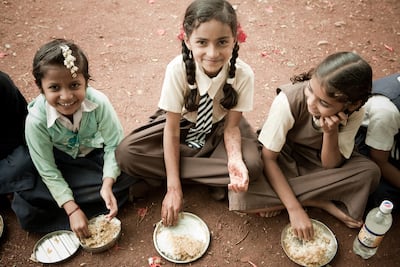India has achieved a remarkable reduction in poverty, a UN agency said, with a 415 million people escaping it in 15 years.
The United Nations Development Programme on Tuesday released the latest global Multidimensional Poverty Index, with estimates for 110 countries, and the Oxford Poverty and Human Development Initiative at the University of Oxford.
The MPI monitors both poverty reduction and tries to measure how people experience poverty in different aspects of their daily lives, for example, whether they have access to education, health, adequate housing and other basics.
"Notably, India saw a remarkable reduction in poverty," Tuesday's press release on the report said, pointing to the rapid economic growth in the time period.
The main indicators include nutrition and child mortality, years in schooling, availability of cooking fuel, drinking water, sanitation and electricity.
“The MPI as a poverty index can be pictured as a stacked tower of the interlinked deprivations experienced by poor individuals, with the aim of eliminating these deprivations,” the UN said in its report.
It found that 25 countries including India, which has a population of 1.4 billion, halved their global MPI values within 15 years, between 2006 to 2021, showing that rapid progress is attainable.
According to the report, there were about 645 million people in multidimensional poverty in India in 2005-6. The number has fallen to about 230 million between 2019 and 2021.
The report found that the proportion of poor families who lacked access to cooking fuel fell from 52.9 per cent to 13.9 per cent, while those deprived of sanitation fell from 50.4 per cent in 2005-6 to 11.3 per cent in 2019-21 in the country.
China also lifted 69 million people out of poverty between 2010 and 2014 and Indonesia succeeded in lifting 8 million people out of poverty between 2012 and 2017, the report said.
Other countries that made notable progress in poverty reduction included Cambodia, Congo, Honduras, Morocco, Serbia and Vietnam.
The report, however, also found that 1.1 billion out of 6.1 billion people across 110 countries – just over 18 per cent – live in acute multidimensional poverty.
“Sub-Saharan Africa, with 534 million, and South Asia, with 389 million, are home to approximately five out of every six poor people,” it said.
More from Neighbourhood Watch:
Credit Score explained
What is a credit score?
In the UAE your credit score is a number generated by the Al Etihad Credit Bureau (AECB), which represents your credit worthiness – in other words, your risk of defaulting on any debt repayments. In this country, the number is between 300 and 900. A low score indicates a higher risk of default, while a high score indicates you are a lower risk.
Why is it important?
Financial institutions will use it to decide whether or not you are a credit risk. Those with better scores may also receive preferential interest rates or terms on products such as loans, credit cards and mortgages.
How is it calculated?
The AECB collects information on your payment behaviour from banks as well as utilitiy and telecoms providers.
How can I improve my score?
By paying your bills on time and not missing any repayments, particularly your loan, credit card and mortgage payments. It is also wise to limit the number of credit card and loan applications you make and to reduce your outstanding balances.
How do I know if my score is low or high?
By checking it. Visit one of AECB’s Customer Happiness Centres with an original and valid Emirates ID, passport copy and valid email address. Liv. customers can also access the score directly from the banking app.
How much does it cost?
A credit report costs Dh100 while a report with the score included costs Dh150. Those only wanting the credit score pay Dh60. VAT is payable on top.
Killing of Qassem Suleimani
Bib%20Gourmand%20restaurants
%3Cp%3EAl%20Khayma%0D%3Cbr%3EBait%20Maryam%0D%3Cbr%3EBrasserie%20Boulud%0D%3Cbr%3EFi'lia%0D%3Cbr%3Efolly%0D%3Cbr%3EGoldfish%0D%3Cbr%3EIbn%20AlBahr%0D%3Cbr%3EIndya%20by%20Vineet%0D%3Cbr%3EKinoya%0D%3Cbr%3ENinive%0D%3Cbr%3EOrfali%20Bros%0D%3Cbr%3EReif%20Japanese%20Kushiyaki%0D%3Cbr%3EShabestan%0D%3Cbr%3ETeible%3C%2Fp%3E%0A
Teams
Punjabi Legends Owners: Inzamam-ul-Haq and Intizar-ul-Haq; Key player: Misbah-ul-Haq
Pakhtoons Owners: Habib Khan and Tajuddin Khan; Key player: Shahid Afridi
Maratha Arabians Owners: Sohail Khan, Ali Tumbi, Parvez Khan; Key player: Virender Sehwag
Bangla Tigers Owners: Shirajuddin Alam, Yasin Choudhary, Neelesh Bhatnager, Anis and Rizwan Sajan; Key player: TBC
Colombo Lions Owners: Sri Lanka Cricket; Key player: TBC
Kerala Kings Owners: Hussain Adam Ali and Shafi Ul Mulk; Key player: Eoin Morgan
Venue Sharjah Cricket Stadium
Format 10 overs per side, matches last for 90 minutes
Timeline October 25: Around 120 players to be entered into a draft, to be held in Dubai; December 21: Matches start; December 24: Finals
UAE currency: the story behind the money in your pockets



